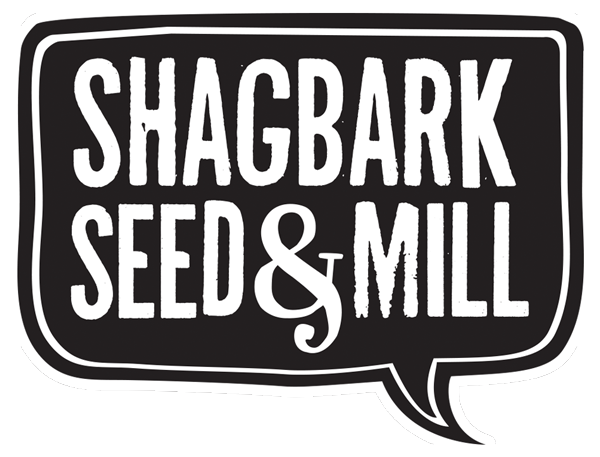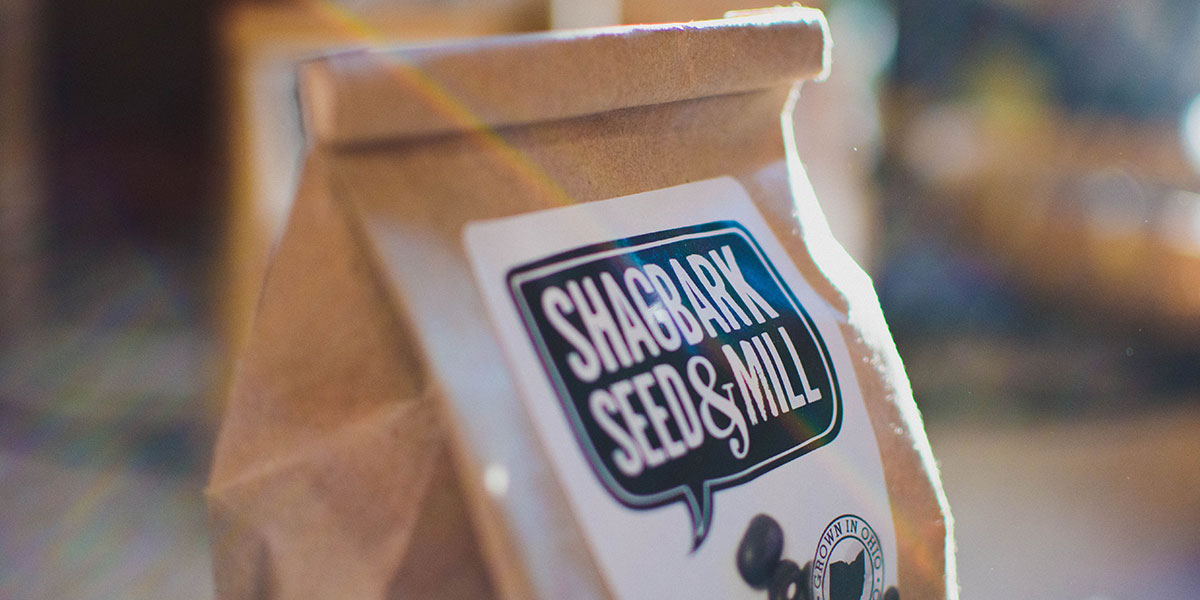Organic Wapsie Valley Dent Heirloom Corn
Corn, more accurately "Maize", is a core staple food crop for so many cultures worldwide, and was originally developed by the ancient peoples of Mesoamerica, starting more than 6000 years ago. Wapsie Valley is a beautiful heirloom, with a rich mix of yellow, red, orange, and purple, delighting the eye and indicating a rich flavor and outstanding nutritive qualities. Wapsie Valley was developed by Adolph Steinbronn at Artesnian Organic Farm in rural Iowa in 1971. It's the only ingredient in Shagbark's Corn Meal, Grits, and Polenta. Ed Snavely and Tom Klein, both Ohio organic farmers, have each told us that they have placed hybrid corn on one end of the pig run, and Wapsie Valley on the other, then let the pigs in. Again and again, the pigs don’t even look at the hybrid corn until every kernel of Wapsie is gone. "They know what’s good for 'em!"
Shagbark's Organic Wapsie Valley Heirloom Corn (non-gluten), is grown at Tom & Mary Klein and Sons Organic Farm. The Kleins never use GMO varieties, as is required to be Certified Organic.
Organic Red Fife Heirloom Wheat
Most varieties of red spring wheat, including Marquis, owe their ancestry to Red Fife, a landrace variety, which was the baking and milling industries' standard of 'wheat' from 1860 to 1900. Red Fife can grow from three to five feet tall, and is thought to have originated in what is now Western Ukraine, where it was called Chervona Vusata. This heirloom is called "Red" because of its color when fully ripe and "Fife" after David Fife, the Ontario farmer who, in 1842, was the first to grow it in North America. For most of the twentieth century, it was only grown in plant breeders’ seed collections. Then Sharon Rempel, who became known as the godmother of Red Fife wheat, planted a "Living Museum of Wheat" in Keremeos B.C. Canada and by the 1990s, enough seed was available to grow it out on several farms.
Shagbark's Organic Red Fife Wheat is grown at Tom & Mary Klein and Sons Organic Farm. The Kleins never use GMO varieties, as is required to be Certified Organic.
Oberkülmer Spelt
From mysterious origins to mystical healing powers, spelt claims a history as rich as its unmistakable sweet, buttery, nutty flavor. Spelt, also known as “Dinkel” or German wheat, developed through the spontaneous crossing of the wild goat grasses "Aegilops squarrosa" and Emmer (an ancient Egyptian grain) between 6000 and 5000 years before the Christian Era. This wilder crop boasts a very impressive lineup of nutritive qualities. In ancient Greek mythology, spelt was given to the people by the goddess Demeter, and in the 12th century, Hildegaard von Bingen, the first nutritionist in Germany, called spelt the best grain of all, and prescribed it for everyday health maintenance and as the first medicine to a very wide range of ailments and conditions. Spelt contains more protein, fats and crude fibre than wheat and also has large amounts of Vitamin B17 (anti-carcinoma). It also contains special carbohydrates which play a decisive role in blood clotting and stimulate the body’s immune system so as to increase its resistance to infection.
Shagbark’s Oberkülmer Spelt is grown at Tom & Mary Klein and Sons Organic Farm. The Kleins never use GMO varieties, as is required to be Certified Organic.
Organic Corn
Corn, more accurately "Maize", is a core staple food crop for so many cultures worldwide, and was originally developed by the ancient peoples of Mesoamerica, starting more than 6000 years ago. The Clinehens chose the most flavorful Organic corn seed for our Original Corn Tortilla Chips, Black Bean & Corn Tortilla Chips, Cornbread Crackers, as well as when we provided fresh Masa and fresh Corn Tortillas. This variety is chosen for the best performance in the ancient Mayan process of Nixtamal, which we use for making our Original Corn Tortilla Chips, Black Bean & Corn Tortilla Chips, Corn Cracker Minis. Nixtamal creates the great flavor that's integral to corn tortillas and makes the B vitamins in corn bioavailable, turning the corn into a superfood.
Our organic hybrid corn is grown by Chris Clinehens his daughter, Ginger, and his wife, Kim, at Clinehens Organic Farm in Shelby County, Ohio. The Clinehens never use GMO varieties, as is required to be Certified Organic.
Heirloom Popcorn
A full kernel heirloom, this unnamed Heirloom Popcorn has been saved for generations, by the Hershberger’s extended family, who grow it using horse drawn equipment, on the Hershberger Family Farms in Morgan County, Ohio.
Organic Dry Beans
Shagbark's dry bean varieties are today's generation of beans that have been at the heart of indigenous foodways in the western hemisphere, where they are native and have been cultivated for thousands of years. Shagbark’s Organic dry beans are fresh from this years harvest, rather than stored for years on warehouse shelves, so they yield the benefits of a shorter cooking time, richer flavor, and superior texture.
Organic Black Beans (Black Turtle Beans)
Organic Black Beans have been the heart of native foodways of North, South, and Central America, loaded with protein, fiber, magnesium, and antioxidants. The black bean is a small, shiny variety of Phaseolus vulgaris, especially popular in Latin American cuisine, and can also be found in Cajun and Creole cuisines of south Louisiana. Black beans are native to the Americas.
The so-called Black Turtle Bean has a dense, meaty texture, which makes it popular in vegetarian dishes, such as frijoles negros and the Mexican-American black bean burrito. It is a very popular bean in various regions of Brazil, and is used in the national dish, feijoada. It is also a main ingredient of Moros y Cristianos in Cuba, and is served in almost all of Latin America, as well as many Hispanic enclaves in the United States. A field of black turtle bean plants stands out among the ubiquitous soybean, primarily because of the distinctive purple flowers.
Grown at Schmitmeyer Organic Farm, in Darke County, Ohio, Shagbark’s organic black beans are fresh from this years harvest, rather than stored for years on warehouse shelves, so they yield the benefits of a shorter cooking time, richer flavor, and superior texture.
Organic Pinto Beans
Called frijol pinto ([fri.ˈxol ˈpin.to]), literally "speckled bean" in Spanish, and known as the poroto frutilla, literally "strawberry bean" in South America, the pinto was also one of the first beans to be mechanically processed. It has been used widely in the South, and in Appalachia, where it replaced many of the vining heirlooms, at least one of which can be traced back several thousand years in Eastern Kentucky. Some organizations and churches in rural areas still sponsor "pinto bean suppers" for social gatherings and fundraisers. The Pinto is known scientifically as Phaseolus vulgaris.
A nutrient-dense legume, the Pinto Bean contains many essential nutrients and is very low in saturated fat. On the other hand, pintos are a good source of protein, phosphorus and manganese, and very high in dietary fiber and folate. Rice and pinto beans, served with cornbread or corn tortilla chips, are often a staple meal where meat is unavailable, their combined amino acids forming a complete protein source.
Grown at Flathill Organic Farm in Seneca County, Ohio, Shagbark’s Organic Pinto Beans are fresh from this years harvest, rather than stored for years on warehouse shelves, so they yield the benefits of a shorter cooking time, richer flavor, and superior texture.



